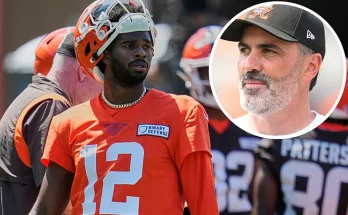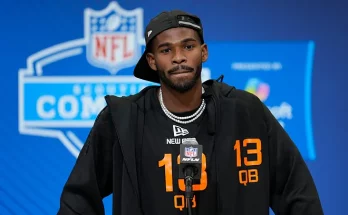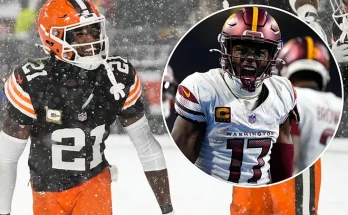There are moments in college football that define not only a game but the player within it. For Christian Gray, the sophomore cornerback at Notre Dame, “The Conversion” wasn’t just a single play—it was a transformation of identity, a coming-of-age moment wrapped in the kind of pressure only a national audience and one of the best wide receivers in the country could bring.
When Gray lined up across from Ohio State’s Jeremiah Smith, the setting was electric. The Fighting Irish were locked in a gritty, low-scoring battle with the Buckeyes, and every possession felt like a fistfight in a phone booth. Smith, a true freshman phenom and the No. 1 wide receiver in the 2024 recruiting class, had already put together a highlight reel season before setting foot in South Bend. The hype was real. The eyes were on him. But Gray was ready.
Notre Dame fans had watched Christian Gray evolve from a high-ceiling freshman with raw speed into a legitimate cornerback who could play with technique and toughness. Still, no test to that point had compared to what he faced against Smith. That was the matchup everyone had circled on the schedule. It was the kind of assignment that could either shake a player’s confidence or catapult him into the spotlight.
And then came the fourth quarter. The Irish clung to a 17-14 lead with less than two minutes remaining. Ohio State had driven into the red zone. Fourth-and-goal from the six. Ryan Day called for a fade to Smith, the same route he had torched defenders with all season. It was the Buckeyes’ best against the Irish’s best. One play for the game.
Gray recalled the moment vividly.
“It’s the kind of play you dream about, but you don’t really know how heavy it is until you’re standing there,” he said. “When I looked up and saw Jeremiah across from me, I knew the ball was coming. You don’t recruit a guy like that and not use him in the biggest moment.”
Gray had done his homework. He knew Smith liked to lean inside before breaking toward the back pylon. He knew that Marvin Harrison Jr. used to run that exact same route, and that Day’s offense was built on precision in those moments. Gray also knew that if he mistimed his jump by half a second, Smith was scoring, and Notre Dame’s playoff hopes were fading.
The snap came. Smith released clean, made his inside move, and darted toward the corner. Gray mirrored him step for step, then turned his head just in time to track the ball. What happened next was what Irish fans now call “The Conversion”—a phrase that’s taken on spiritual significance on Notre Dame message boards and within the locker room. Gray elevated, twisted his body, and swatted the ball out of the air with the tips of his fingers.
Incomplete. Turnover on downs. Notre Dame ball.
The stadium erupted. It wasn’t just a stop—it was an exclamation point. Gray flexed toward the student section, helmet slightly askew, his teammates pouring in from all sides. The Irish would run out the clock and escape with a win that felt like a spiritual release. The play itself didn’t just save a game; it elevated a program and validated a rising star.
But for Gray, it wasn’t about the theatrics.
“I didn’t celebrate because I made a play,” he said. “I celebrated because I didn’t let my brothers down. That was everything.”
The term “The Conversion” was born almost immediately. Head coach Marcus Freeman joked about it postgame, saying, “I don’t know what’s more poetic—Christian’s name or the way he baptized that ball out of Jeremiah’s hands.” The phrase stuck, and quickly grew legs on social media. TikToks broke it down frame by frame. Twitter lit up with memes. Even campus ministry got in on the joke, posting a tongue-in-cheek breakdown of the “Christian conversion experience.”
But the significance of the moment wasn’t lost on those closest to Gray.
His position coach, Mike Mickens, saw it as a culmination of months of behind-the-scenes growth. “You see the play and think, ‘Wow, that kid’s a baller,’ but what you don’t see is the film study, the 6 a.m. lifts, the missed reps he stayed after practice to run again and again. That play was a product of investment. That wasn’t a fluke. That was Christian understanding the assignment and rising to meet it.”
Gray, soft-spoken off the field, didn’t bask in the moment for long. The following Monday, he was back in the film room, grading his performance.
“Yeah, I made that play,” he said, smiling. “But I also gave up a 12-yard curl in the second quarter that I should’ve jumped. There’s always more.”
Still, no one in the building could ignore what that moment meant—for Gray, for the defense, and for Notre Dame’s broader trajectory.
It was a signal that the Irish could hang with the elite, not just in the trenches, but on the edges—where modern college football is increasingly won and lost. For years, Notre Dame had built its identity on toughness and tradition, sometimes at the expense of elite perimeter play. But with players like Gray emerging, and recruits like Leonard Moore and Karson Hobbs waiting in the wings, the Irish secondary was no longer an afterthought. It was a weapon.
Smith, for his part, didn’t hide his frustration after the game. The freshman phenom had dominated all season but was held to just four catches for 48 yards against the Irish—his lowest output of the year.
“I tip my hat to him,” Smith said postgame. “He played a hell of a game. That’s football. You win some, you learn some.”
When asked what Gray said to him after the play, Smith nodded and replied, “He just said, ‘Respect.’ And I gave it back.”
That mutual respect is part of what made the play special. There was no taunting, no trash talk. Just two elite competitors going head-to-head on the biggest stage. And when the moment called, Gray responded.
Off the field, Gray is as grounded as they come. A product of DeSmet Jesuit High School in St. Louis, he speaks often about faith, family, and focus. When asked about “The Conversion,” he paused.
“Look, I’m grateful people see that play as something big,” he said. “But it wasn’t just me. It was our pass rush making the QB get it out fast. It was our safeties communicating pre-snap. It was the scout team giving me that exact look all week. I just happened to be the one who got the spotlight. But it’s a team thing. Always has been.”
Still, spotlight or not, the play has already entered Irish lore. Notre Dame hasn’t won a national title since 1988, but moments like Gray’s have begun to shift the perception that the program is stuck in the past. Under Freeman, the Irish have leaned into development, speed, and swagger—three traits Gray personifies on every snap.
Former Notre Dame great Julian Love, now in the NFL, tweeted after the game: “Christian Gray just put himself on the map. CB1-type play. Book it.”
That “CB1” label isn’t just talk anymore. NFL scouts are watching. Opponents are adjusting. And Gray is embracing the challenge.
“I’m just getting started,” he said. “That play? That was one chapter. I’m trying to write a whole book.”
The best part? He believes the story is still unfolding.
Whether Notre Dame makes a playoff run this year or not, “The Conversion” will remain one of those moments etched in golden memory. It was a reminder that sometimes, all it takes is one perfectly timed leap, one deflection, one refusal to blink—to convert a player into a legend.



